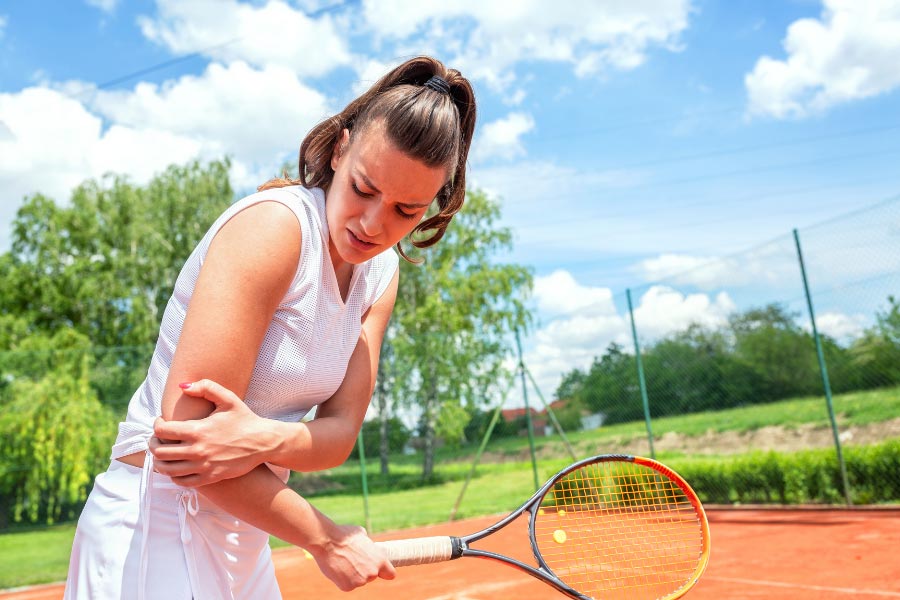Tennis elbow, also known as lateral epicondylitis, is a common condition that affects many Australians, particularly those who engage in repetitive arm and wrist activities. Despite its name, you don’t need to play tennis to develop this condition. This blog post will provide an overview of tennis elbow, its symptoms, causes, and how osteopathic treatment can offer relief.
What is Tennis Elbow?
Tennis elbow is characterised by pain and inflammation on the outer part of the elbow. This discomfort is often the result of repetitive strain on the forearm muscles and tendons, leading to microtears in the tendons attached to the lateral epicondyle, the bony prominence on the outer elbow.
Common Symptoms of Tennis Elbow
- Pain and Tenderness: The primary symptom is pain on the outer part of the elbow. This pain can range from mild to severe and may extend down the forearm.
- Weak Grip Strength: Difficulty gripping objects or performing tasks that require forearm strength, such as shaking hands or lifting items.
- Stiffness: The elbow may feel stiff, particularly in the morning or after periods of inactivity.
- Pain with Specific Movements: Activities that involve wrist extension, such as holding a tennis racket or using a screwdriver, may exacerbate the pain.
Causes and Risk Factors
Tennis elbow is typically caused by repetitive motion and overuse of the forearm muscles. While playing tennis is a common cause, other factors can contribute to the development of this condition:
- Repetitive Strain: Activities such as painting, gardening, and typing can place repetitive stress on the elbow.
- Improper Technique: Using improper techniques during sports or manual work can increase the risk.
- Age: Tennis elbow is more common in adults between 30 and 50 years of age.
- Occupation: Jobs that require repetitive arm movements or heavy lifting can be risk factors.
Treatment and Management
Osteopathic treatment focuses on a holistic approach to address the underlying causes of tennis elbow. Here’s how an osteopath can help:
-
Assessment and Diagnosis: An osteopath will perform a thorough assessment to understand your specific symptoms and the activities that might be contributing to your condition. This includes a detailed physical examination and review of your lifestyle.
-
Manual Therapy: Techniques such as soft tissue massage, stretching, and mobilisation of the elbow joint can help reduce pain and improve flexibility.
-
Exercise Rehabilitation: Tailored exercises can strengthen the muscles of the forearm and improve tendon health. Stretching exercises may also be recommended to enhance range of motion.
-
Postural and Ergonomic Advice: An osteopath can provide guidance on improving posture and ergonomics to prevent further strain on the elbow. This might include adjustments to your workstation or advice on proper techniques for activities that aggravate your condition.
-
Lifestyle Modifications: Recommendations may include changes to your daily activities or introducing rest periods to allow the elbow to heal.
Prevention
Preventing tennis elbow involves taking steps to reduce the strain on your elbow:
- Warm-Up: Always warm up before engaging in physical activities, particularly those involving repetitive arm movements.
- Proper Technique: Ensure you use correct techniques in sports and manual work.
- Strengthening Exercises: Regular exercises to strengthen the forearm muscles can help protect against injuries.
- Ergonomic Adjustments: Make sure your workstation is set up to minimise strain on your arms and elbows.
Tennis elbow can be a painful and disruptive condition, but with the right approach, relief and recovery are achievable. If you’re experiencing symptoms of tennis elbow, consulting with an osteopath can provide a comprehensive treatment plan tailored to your needs. By addressing both the symptoms and underlying causes, osteopathic care can help you return to your daily activities pain-free and prevent future occurrences.
Struggling with tennis elbow? Book an appointment with one of our experienced osteopaths today to receive personalised care and start your journey towards pain relief and recovery. Don’t let elbow pain hold you back!
References
Australian Family Physician. (2020). Lateral epicondylitis. The Royal Australian College of General Practitioners. https://www1.racgp.org.au/ajgp/2020/november/lateral-epicondylitis
Australian Government Department of Health. (2024). Tennis elbow (lateral epicondylitis). HealthDirect Australia. https://www.healthdirect.gov.au/tennis-elbow

